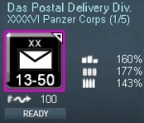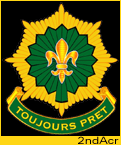wosung
Posts: 692
Joined: 7/18/2005
Status: offline

|
quote:
ORIGINAL: kirkgregerson
Ok, I've been reading a few of the following books lately that have been describing how the German Pz Div were almost 'super-human' in dealing with some of the most incredible tasks of defending an attacking.
To the Gates of Stalingrad: Soviet-German Combat Operations, April-August 1942: David Glantz
The 6th Panzer Division 1937-1945: Helmut Ritgen
These mobile units were called upon by the Germany army over and over again to be the 'fireman' and/or spearheads when needed.
In all the readings I've yet to see an example of a sov Rifle div accomplishing what happen in this fictional WitE battle given the circumstances. Here's a little blurb which I found about the Kharkov 2nd battle:
[...]
In in almost all cases of the 42 battles, a sov rifle div caught in the open was cannon-fodder for a German Pz Div.
Ok, I've been reading a few of the following books lately that have been describing how the German Pz Div were almost 'super-human' in dealing with some of the most incredible tasks of defending an attacking.
I find your talking about “almost superhumans” and “cannon fodder” very ... brave, like the talk of the OP about “utter madness”. It tells me that, even if you refer to Glantz, you base you infos mainly on post war Nazi general’s historical fiction. Granted, those books make a fun reading. And apparently those Wehrmacht myths still manage to manipulate our perception to this very day.
Look what those German generals and officers wrote in spring 1942:
Report of German commander 3. Panzerdivision somewhere in spring 1942 „in preperation of a big summer offensive“:
“The Russian infantry is equipped badly. It will only attack when escorted by tanks. [...]. The Russians can’t stop a strong German attack. The Russian will panic and give up his position. This happened esp. During the combats near Charkov and also on Crim pensinsular. However it should be explicitely stressed, that this only happened as a conseqiuence of massive Panzer attacks. When attacked at company level, [the Russian], will re-occupy his foxhole, after he has recognized the the small number of Panzer, and the he will defend stubbornly against the following up [ German] infantry. Everytime a successfull German breakthrough happens it became necessary to chase the enemy relentlessly even at night.. Esp. At night, he managed to recombine together many troop elements. Thus, when [our] attack was continued in the morning a new line of defense had to be breeched. The Russians became very active in our flanks.” Source: Jentz, Panzertruppen(German ed.), Vol. 1, pp. 232-233.
An example of a German attack by 22. Panzer division fubared on March 20 1942 at the Crim:
33 tanks of P. Reg. 204’s 142 tanks had to be given up. The German report of the debacle stressed, that it happened because preperation and cooperation between Panzer and pts. of the German rifle regiment, which took part was lacking. Not, that 22. PD. was a green unit, it’s enemy was dug in and had some 40 tanks at it’s disposal. Source: Jentz, Panzertruppen (German ed.), Vol. 1, pp. 224-228.
German commanders about the successful destruction of the Charkov-Izjum pocket in May 1942 (Fredericus I):
“’The battle field shows the violence of the fight’, Kleist wrote in an AAR. ‘ At the focus of the battle the soil is densely covered by corpses of horses and humans, thus it takes an effort to find a path driving through.’
Such experiences weren’t without effect on the spectators and survivors. Apart from the various forms of mental stress, which can’t be found easily in the files, they forced some troop leaders to take a blunt, sceptical view, as to the future. Von Mackensen, commanding General of Group Kleist’s III. Panzerkorps wrote after the battle near Charkov, that the enemy operations became ‘more fanatically, recklessly and united’ than in 1941.” The Red leaders risk all. As to the grand perspective of things they decide very clearly, and take every possible step to put those decisions into practice. In this, now they are followed by commanders and troops much more closely than last year. [...] The Red armourd force and Cavalry distinguish themselves by an unprecedented bravery and fighting spirit, even if that means their total annihilation.’ According to Mackensen, victory still could be achieved, because of the German bravery and fighting spirit, because of the Auftragstaktik, because of the tactical surprise, because of the weather and because of the quality of the new material. The General concluded in a first hand AAR, our troops know, that the victory of annihilation only came with a last ditch effort.” Source: Bernd Wegner, Der Krieg gegen die Sowjetunion 1942/43, in: Das Deutsche Reich und der Zweite Weltkrieg [German Reich and WW 2], vol. 6, pp. 860-881.
Assessment of the fighting strength of the divsions in the Ostheer (30.3.1942)
Out of 162 German divisions only 8 were assessed as “fully misssion capable”. Those were distributed in 6 AOK’s, among them only 2 Panzer AOK’s, meaning probably not all of those were Panzer divisions.
Regards
< Message edited by wosung -- 1/26/2011 7:49:25 PM >
|
 Printable Version
Printable Version

















 ) it would be weird if such a result was repeated all that often.
) it would be weird if such a result was repeated all that often.
 New Messages
New Messages No New Messages
No New Messages Hot Topic w/ New Messages
Hot Topic w/ New Messages Hot Topic w/o New Messages
Hot Topic w/o New Messages Locked w/ New Messages
Locked w/ New Messages Locked w/o New Messages
Locked w/o New Messages Post New Thread
Post New Thread